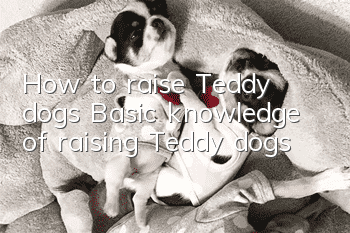How to raise Teddy dogs Basic knowledge of raising Teddy dogs

Living environment
Teddy will feel scared and uneasy when he first arrives in a strange environment, let alone a young puppy. It is recommended to prepare a transportation cage for Teddy and place it in a quiet corner. You can prepare a soft cloth pad, and they usually like to lie on it. Little teddy dogs like to be close to people, and even more like to follow you at your feet. At this time, a transport cage is beneficial.
Environmental Arrangement
Please place a bowl of water and food near the transport cage or sleeping pad. Changing the water several times a day is the healthiest thing you can do. If you need to work during the day, the water must be changed in advance.
Cloth toys, educational toys, and tennis balls can all be placed on the cloth mat, allowing them to enjoy the joy of "eating when they are full, sleeping when they are full, playing when they are full, and eating when they are full". Puppies are full of curiosity about the environment. They want to smell, see, touch and bite everything. You can place safe chew-resistant toys, chew-resistant cotton ropes, etc. to allow Teddy dogs to explore freely. Be careful with items at home. Place and wires should also be well protected to prevent accidents! In addition, put an alarm clock with a ticking sound, because the ticking sound is like the mother's heartbeat, or play a radio (especially talking programs), This way the Teddy dog will feel more secure.
Growth and Development of Teddy Dogs
The normal development of a furry baby after birth is:First week: Nestled in mother’s arms, sucking milk and sleeping, occasionally crawling to find milk to drink.
Second week: Slowly open your eyes and ears, and start to learn to stand.
The third week: slowly take steps and learn to walk, reacting to swaying and shiny things.
Week 1: Begin to recognize the bitch and the owner; from this week onwards, weaning can be carried out gradually,
replace it with milk powder for two days, and then slowly switch to dog food.
?Fifth week: Baby teeth appear, eyes can see, ears can hear, and life education can begin, such as toilet training, rewards and encouragement... etc. Week 6: Vaccination to prevent viral diseases and deworming.
Potty training
After weaning (about five weeks later), urinary training can begin. A puppy's memory of what's in the toilet will last a lifetime. It can be trained using newspapers. Usually you have a bowel movement 15-30 minutes after you are full, and you may urinate more frequently. So after eating, take the puppy to the toilet where the newspaper is placed. Praise and reward him whenever he urinates. The Teddy dog knows that the owner in that place will be very happy, and naturally will not urinate and defecate indiscriminately. However, the puppy cannot control urination at will 3 months ago, so the requirements are not too high, and the owner can do it with a little patience!- What do dogs eat to protect their stomach? It is important to protect their stomach and treat gastrointestinal diseases in dogs.
- How to tell if your dog is fat? Is your dog overweight?
- Will your dog catch a cold if you blow the air conditioner? What should you do if your dog catches a cold if you blow the air conditioner?
- What should you pay attention to when your dog drinks water? Don’t be careless when it comes to your dog’s drinking water.
- The dog's mouth bites and shakes. Why does the dog's mouth occasionally shake and bite?
- How to cut a dog's hair? Do you know how to cut a dog's hair correctly?
- Can dogs eat raw eggs? Why can’t dogs eat egg whites?
- Common Dog Problems in Summer How to Deal with Different Dog Problems
- How to keep dogs away from skin diseases. If you do this, will you see if your dog will still be infected with skin diseases?
- What causes anorexia in dogs? Dogs will become anorexic due to lack of exercise. Hounds run at least 5KM every day.



